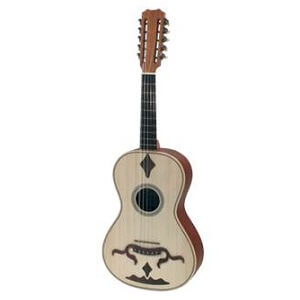Viola Braguesa
 The braguesa viola was born in the seventeenth century, in Braga, Portugal, as the name suggests. Used to liven up popular parties in conjunction with other stringed instruments such as the cavaquinho and even competing with bagpipes, the viola braguesa has witnessed a revival in recent years. Bands of more contemporary styles have played it together with electrified instruments. But anyone who was competing with a bagpipe survives everything.
The braguesa viola was born in the seventeenth century, in Braga, Portugal, as the name suggests. Used to liven up popular parties in conjunction with other stringed instruments such as the cavaquinho and even competing with bagpipes, the viola braguesa has witnessed a revival in recent years. Bands of more contemporary styles have played it together with electrified instruments. But anyone who was competing with a bagpipe survives everything.
Artimúsica has built a resistant instrument that respects the design and traditional techniques of manufacture, in the finishes and in the choice of materials. The top is in linden, the bottom and the sides are in walnut and the fretboard in panga panga. The decor is simple but full of traditional motifs, with a strikingly striking mouth.
With a belted body, smaller than a traditional viola, it maintains many similarities and kinships with other Portuguese traditional guitars and violas, like the amarante viola, the Portuguese guitars of Lisbon and Coimbra. It is used predominantly to play "chulas", "malhões" and "viras" but, as we have seen, it has been explored in other musical styles.
The braguesa viola has five folded strings, that is, 10 strings arranged in five pairs, with the two pairs more acute tuned in unison and the three pairs more serious tuned in octaves. There are several tunings for the braguesa viola being the most popular the "Mouraria Velha"